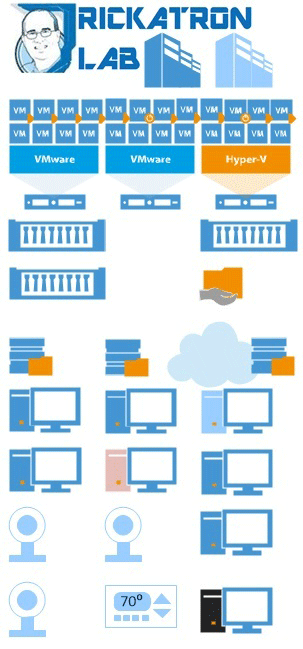My Virtual Home Lab Upgrade
For IT pros, I think that the home lab has been one of the most critical tools to allow us to further our professional careers, prepare for certifications and go into the workplace with confidence. Further, if you're like me, the home lab does part of the household IT services. My most popular personal blog post is my rough overview of my home lab from January 2010. It is indeed rough, as I (shudder) diagrammed my home lab at the time with a permanent marker.
That was more than five years ago. Some of those components were new at the time, some have come and gone, and yet some are still there. Recently, my primary battery unit to power the whole lab failed. I was very lucky, though; I got nearly eight years out of a 2U rack-mount battery. Due to this failure, my initial thought was to just get a new battery. But I thought: It's 2015. What's the role of the home lab? What do I need to do differently or additionally to use new technologies? Figure 1 shows my current setup.
 Figure 1. Rick's home lab is quite complex.
Figure 1. Rick's home lab is quite complex.
There's a lot going on here, but primarily note that there are two VMware vSphere 5.5 hosts and one Hyper-V Server 2012 host with a number of VMs. I have a large file server as a VM that holds every piece of data my family or I would ever need, and it's quite large. In fact, this lab is something of a production environment, as I have a proper domestic business with an official employee. So the data I store is important for that.
There are three iSCSI storage systems, one NAS system and one iSCSI storage device dedicated to backups. There's also a fireproof hard drive for backups, and a cloud backup repository. All the PCs, tablets, webcams, streaming media players, phones, TVs and the thermostat are connected to the network behind an Untangle virtual appliance. The Untangle is staying, that's for sure -- it's the best way to do free content filtering.
Single Hypervisor?
The whole lab arrangement is complex, but I understand it and know how to support it. Additionally, most of the blogs I do here are seeded in this lab. That's where I am today, but what's the next logical step in the home lab? Part of me wants to retire each of the older VMware hosts and just use the Hyper-V host because it's newer. That would require me to settle on a single hypervisor, which is a discussion for another day.
I still think there are benefits to having two hosts in a home lab. For one, availability and migration are options in case of a failure. But what needs to change are all the storage devices. They draw a lot of power and have hard drives that will surely soon fail (don't worry – I'm good on the backups).
I've gone all solid state on endpoints, and that's an investment with which I've been happy. With all of that being said, I still want the Rickatron lab to do the fun stuff like nested virtualization, vMotion, high availability and more.
The new home lab will have a reduced number of storage devices. I'm tempted to go all local storage and use replicated VMs in addition to my backups. Because I only have one Hyper-V host and it's newer, I'll move all of those VMs to local storage.
The VMware VMs, though, need to keep their ability to migrate, so I think the right step today is to get one storage resource that's faster and offers more capacity than what I have now. Also, for the home lab I don't need features such as VMware Virtual SAN because two hosts are fine for me, and Virtual SAN requires three.
Backups
Regarding backups, I'm still going to practice the 3-2-1 rule. It states that there should be three different copies of data on two different forms of media, with one of them being off-site. I like this rule as it doesn't lock into any specific technology and can address nearly any failure scenario.
For the lab, I may also invest in a new backup storage resource. Besides, when I need it, I need it to work and be fast. So whatever the primary storage device will be, I'll likely purchase a second one dedicated to backup storage. I'll still leverage the cloud repository backup strategy, as well, which will address my off-site requirement.
My use case for a home lab is unusual, with a design that shares many small business requirements minus the mixed hypervisor twist. Do you have a home lab? What would you do differently if you had to change it? I'm going for fewer devices next time. Share your strategies in the comments section.
Posted by Rick Vanover on 03/18/2015 at 9:10 AM